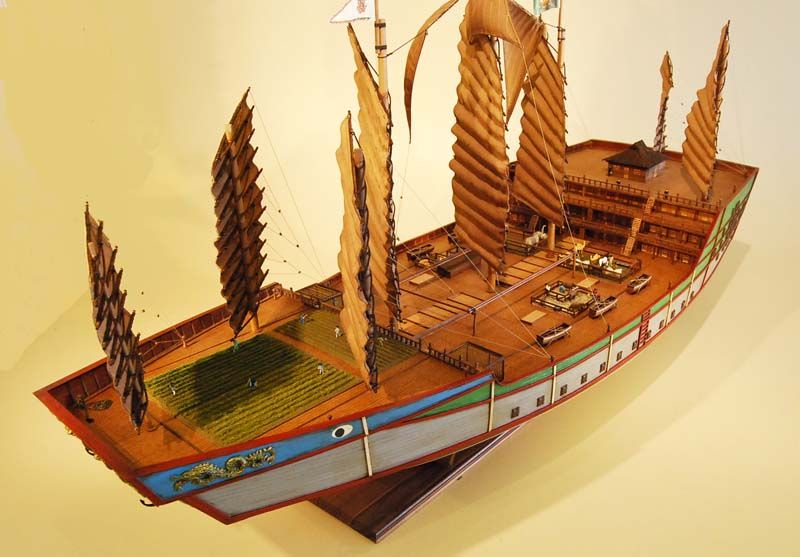
Imagine hundreds of mighty ships, sailing over the horizon with bright red sails, with some vessels being the biggest of the time.
This would have been the magnificent and terrifying sight that coastal peoples would have seen in the 15th century, thanks to the voyages of one Admiral Zheng He.
Almost every Malaysian knows of Zheng, the Chinese envoy who visited the Melaka Sultanate to initiate diplomatic relations between the two countries.
He was more than just a mere diplomat though, and his story of life-long exploration and adventure is sadly unknown in the West.
So, who was the man in charge of one of the mightiest fleets in history?
Born in 1371 as Ma He into a possibly Persian Muslim family, his father worked as an official in Yunnan province for the Yuan dynasty.
After being made a eunuch, he became a loyal servant to the man who would become Emperor Yongle of the Ming.
For his service, he was bestowed the name Zheng, after the ruler’s favourite horse.

Yongle was an ambitious emperor, responsible for sending out military expeditions and developing the imperial capital at Beijing.
He also wished to have China’s authority recognised in lands far and wide and for that reason, chose Zheng He for the job.
The fleet that was assembled for Zheng’s voyage was nothing short of impressive, with the so-called Treasure Ships measuring 137 metres in length and 61 metres in width.
They dwarfed many European ships at the time and were brilliantly designed to last for long voyages.
Onboard these ships were 27,000 crewmen consisting of cooks, sailors, doctors, scholars, soldiers and even horsemen whose mounts were kept in stables on the ships.
The first voyage of Zheng began in 1405 with a prayer to the Mazu, the Chinese sea goddess.
Sea travel at the time was dangerous, but the fleet was equipped with magnetic compasses, sea charts and star charts, which improved their chances.
Afterwards, the fleet would visit Vietnam and Sumatra before sailing onto India.
He arrived in Kozhikode in modern-day Kerala , where he exchanged state gifts with the rulers there.

It must have been an interesting experience for his crew, with India being a completely different and interesting culture to them.
With his ships laden with goods, Zheng headed home, only to learn that a pirate lord, Chen Zuyi, was waiting in the Strait of Malacca for him.
A naval clash near Palembang followed, which saw Zheng defeating and later capturing the pirate, bringing him back to China to face justice.
It was during his third voyage when the fateful meeting between him and Parameswara, founder of Malacca, took place.
With the Majapahit and the Siamese threatening Malacca’s security, Parameswara agreed to recognise the Emperor’s authority, being granted protection in exchange for his fealty.
After this diplomatic success, Zheng proceeded to load up his ships with local spices before heading off to Sri Lanka.
There, Zheng ran into trouble with a local ruler, who thought the Chinese were there to steal a sacred Buddhist relic.
A clash occurred, with Zheng managing to escape an ambush and instead, captured the hostile king before transporting him back to China.

While the king was spared and allowed to return home, a new king was put in power with the Emperor’s blessing, in exchange for diplomatic tribute.
Zheng went beyond India on his fourth voyage in 1413, when he travelled to the Middle East to make contact with the sultanates there.
He would then return to China, after making a stop in Jawa to intervene in a civil war for the throne of Pasai.
During his time in the Middle East, his fleet took on an assortment of exotic goods, which included African lions and leopards.
Rather amusingly, he was also presented with a giraffe which court officials mistook to be the mythical Chinese creature called the qilin.
The sighting of a qilin was said to be an auspicious event which only took place during a reign of a great ruler.
His fifth voyage saw him returning to the Middle East, gathering Arabic treasures in Yemen including ostriches and zebras.
He would also go on to visit East Africa, where the fleet was welcomed warmly, though there was apparently a moment when Zheng fired a cannon into a hostile town’s walls.

The time of great voyaging was coming to an end though and in 1431, Zheng would embark on his sixth and last voyage.
He would not return to China, having died while in port in Kozhikode in 1433.
As befitting the man of the sea that he was, he would be buried at sea.
The death of Zheng He and that of his Emperor meant that the voyages would be no more.
Some theories suggest that the Treasure Fleet was scrapped for political reasons, but it’s more likely that their maintenance was a costly affair.
In an insult to his legacy, Emperor Jiajing would order Zheng’s logbooks burnt to erase him from history and turn China into an isolationist state.
Zheng had already left his mark on history though, with Chinese trade goods being highly coveted in Southeast Asia and Chinese overseas communities being established in the region.
Being a man of faith, Zheng also had built mosques in the places he visited, some of which still stand today.
As it turns out, it is hard to erase a person’s accomplishments in death when they accomplished much in life.